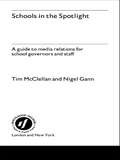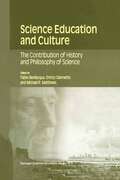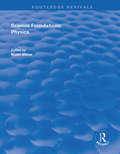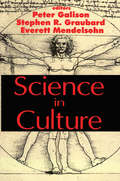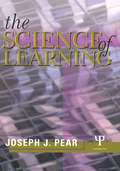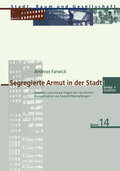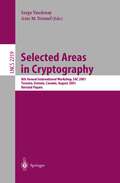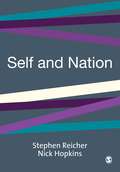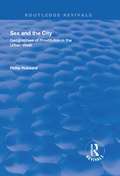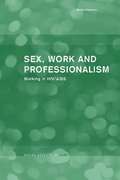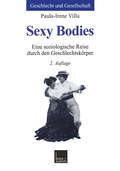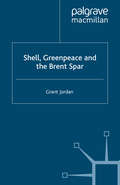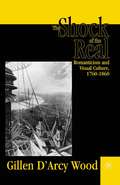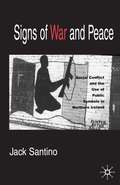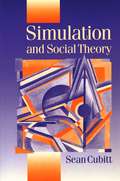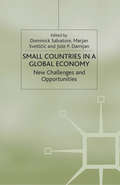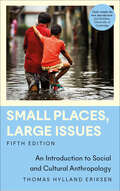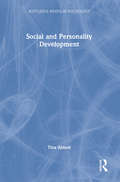- Table View
- List View
Schools in the Spotlight: A Guide to Media Relations for School Governors and Staff
by Mr Nigel Gann Nigel Gann Tim McClellan Tim McclellanWhat role does a school play in a community and society?This book examines the need for educational establishments to review their position in the local community and to develop strategies to deal with the management of their image. Increasing parental choice means that schools must begin to adopt marketing concepts and tell people what is happening both inside and outside the classroom.Techniques to generate, revisit and challenge a school's ethos are discussed together with ways of getting this message across to the wider community. Effective management of a school's image through judicious handling of the media can lead to better results, higher self-esteem for staff and pupils and a greater recognition of a school's contribution to a local community.This book gives practical guidance on how to identify potential news items and how to convince local newspapers, television and radio organisations to use the story. The book contains many examples of how schools have put comprehensive framework to effective media communication and how to avoid potential pitfalls.
Schools in the Spotlight: A Guide to Media Relations for School Governors and Staff
by Mr Nigel Gann Nigel Gann Tim McClellan Tim McclellanWhat role does a school play in a community and society?This book examines the need for educational establishments to review their position in the local community and to develop strategies to deal with the management of their image. Increasing parental choice means that schools must begin to adopt marketing concepts and tell people what is happening both inside and outside the classroom.Techniques to generate, revisit and challenge a school's ethos are discussed together with ways of getting this message across to the wider community. Effective management of a school's image through judicious handling of the media can lead to better results, higher self-esteem for staff and pupils and a greater recognition of a school's contribution to a local community.This book gives practical guidance on how to identify potential news items and how to convince local newspapers, television and radio organisations to use the story. The book contains many examples of how schools have put comprehensive framework to effective media communication and how to avoid potential pitfalls.
Science Education and Culture: The Contribution of History and Philosophy of Science
by Fabio BevilacquaThis anthology contains selected papers from the 'Science as Culture' conference held at Lake Como, and Pavia University Italy, 15-19 September 1999. The conference, attended by about 220 individuals from thirty countries, was a joint venture of the International History, Philosophy and Science Teaching Group (its fifth conference) and the History of Physics and Physics Teaching Division of the European Physical Society (its eighth conference). The magnificient Villa Olmo, on the lakeshore, provided a memorable location for the presentors of the 160 papers and the audience that discussed them. The conference was part of local celebrations of the bicentenary of Alessandro Volta's creation of the battery in 1799. Volta was born in Como in 1745, and for forty years from 1778 he was professor of experimental physics at Pavia University. The conference was fortunate to have had the generous financial support of the Italian government's Volta Bicentenary Fund, Lombardy region, Pavia University, Italian Research Council, and Kluwer Academic Publishers. The papers included here, have or will be, published in the journal Science & Education, the inaugural volume (1992) of which was a landmark in the history of science education publication, because it was the first journal in the field devoted to contributions from historical, philosophical and sociological scholarship. Clearly these 'foundational' disciplines inform numerous theoretical, curricular and pedagogical debates in science education. Contemporary Concerns The reseach promoted by the International and European Groups, and by the journal, is central to science education programmes in most areas of the world.
Science Foundations: Physics
by Bryan MilnerThis title was first published in 2001. The new edition of Science Foundations provides comprehensive coverage of single- and double-award GCSE science. It is fully revised and updated to match the new GCSE specifications, for teaching from September 2001. It contains all the material required for the foundation and higher tiers, with clear progression and explicit differentiation. 'Higher tier only' material is clearly marked in separate spreads. The language level is carefully controlled, with illustrations and layout specifically designed to make the concepts accessible. There are frequent opportunities for students to confirm their understanding of each key idea as it is introduced, via short questions and summary passages on each spread. The books include guidance for students on how to prepare for and answer their GCSE examinations, and a glossary of key words for ease of reference.
Science Foundations: Physics
by Bryan MilnerThis title was first published in 2001. The new edition of Science Foundations provides comprehensive coverage of single- and double-award GCSE science. It is fully revised and updated to match the new GCSE specifications, for teaching from September 2001. It contains all the material required for the foundation and higher tiers, with clear progression and explicit differentiation. 'Higher tier only' material is clearly marked in separate spreads. The language level is carefully controlled, with illustrations and layout specifically designed to make the concepts accessible. There are frequent opportunities for students to confirm their understanding of each key idea as it is introduced, via short questions and summary passages on each spread. The books include guidance for students on how to prepare for and answer their GCSE examinations, and a glossary of key words for ease of reference.
Science in Culture
by Stephen R. GraubardTwenty-five years ago, Gerald Holton's Thematic Origins of Scientific Thought introduced a wide audience to his ideas. Holton argued that from ancient times to the modern period, an astonishing feature of innovative scientific work was its ability to hold, simultaneously, deep and opposite commitments of the most fundamental sort. Over the course of Holton's career, he embraced both the humanities and the sciences. Given this background, it is fitting that the explorations assembled in this volume reflect both individually and collectively Holton's dual roots. In the opening essay, Holton sums up his long engagement with Einstein and his thematic commitment to unity. The next two essays address this concern. In historicized form, Lorraine Daston returns the question of the scientific imagination to the Enlightenment period when both sciences and art feared imagination. Daston argues that the split whereby imagination was valued in the arts and loathed in the sciences is a nineteenth-century divide. James Ackerman on Leonardo da Vinci meshes perfectly with Daston's account, showing a form of imaginative intervention where it is irrelevant to draw analogies between art and science. Historians of religion Wendy Doniger and Gregory Spinner pursue the imagination into the bedroom with literary-theological representations. Science, culture, and the imagination also intersect with biologist Edward Wilson and physicist Steven Weinberg. Both tackle the big question of the unity of knowledge and worldviews from a scientific perspective while art historian Ernst Gombrich does the same from the perspective of art history. To emphasize the nitty-gritty of scientific practice, chemists Bretislav Fredrich and Dudley Herschback provide a remarkable historical tour at the boundary of chemistry and physics. In the concluding essay, historian of education Patricia Albjerg Graham addresses pedagogy head-on. In these various reflections on science, art, literature, philosophy, and education, this volume gives us a view in common: a deep and abiding respect for Gerald Holton's contribution to our understanding of science in culture. Peter Galison is Mallinckrodt Professor of History of Science and of physics at Harvard University. Stephen R. Graubard is editor of the American Academy of Arts and Sciences and its journal, Daedalus, and professor of history emeritus at Brown University. Everett Mendelsohn is director of the History of Science Program at Harvard University.
Science in Culture: His Legacy In Science, Art, And Modern Culture
by Peter Galison Stephen R. Graubard Everett MendelsohnTwenty-five years ago, Gerald Holton's Thematic Origins of Scientific Thought introduced a wide audience to his ideas. Holton argued that from ancient times to the modern period, an astonishing feature of innovative scientific work was its ability to hold, simultaneously, deep and opposite commitments of the most fundamental sort. Over the course of Holton's career, he embraced both the humanities and the sciences. Given this background, it is fitting that the explorations assembled in this volume reflect both individually and collectively Holton's dual roots. In the opening essay, Holton sums up his long engagement with Einstein and his thematic commitment to unity. The next two essays address this concern. In historicized form, Lorraine Daston returns the question of the scientific imagination to the Enlightenment period when both sciences and art feared imagination. Daston argues that the split whereby imagination was valued in the arts and loathed in the sciences is a nineteenth-century divide. James Ackerman on Leonardo da Vinci meshes perfectly with Daston's account, showing a form of imaginative intervention where it is irrelevant to draw analogies between art and science. Historians of religion Wendy Doniger and Gregory Spinner pursue the imagination into the bedroom with literary-theological representations. Science, culture, and the imagination also intersect with biologist Edward Wilson and physicist Steven Weinberg. Both tackle the big question of the unity of knowledge and worldviews from a scientific perspective while art historian Ernst Gombrich does the same from the perspective of art history. To emphasize the nitty-gritty of scientific practice, chemists Bretislav Fredrich and Dudley Herschback provide a remarkable historical tour at the boundary of chemistry and physics. In the concluding essay, historian of education Patricia Albjerg Graham addresses pedagogy head-on. In these various reflections on science, art, literature, philosophy, and education, this volume gives us a view in common: a deep and abiding respect for Gerald Holton's contribution to our understanding of science in culture. Peter Galison is Mallinckrodt Professor of History of Science and of physics at Harvard University. Stephen R. Graubard is editor of the American Academy of Arts and Sciences and its journal, Daedalus, and professor of history emeritus at Brown University. Everett Mendelsohn is director of the History of Science Program at Harvard University.
The Science of Learning
by Joseph J. PearGrowing at an ever-increasing pace for over a century, the solid body of concepts and facts that constitute the science of learning demand a comprehensive, systematic introduction. Completely up-to-date and written in a direct, easy-to-read style that is suitable for undergraduates, The Science of Learning is such an introduction. Because its focus is on what is known rather than what is speculated, this book differs from other learning texts by not dwelling on which theories are or are not in vogue. The text's comprehensive coverage makes it an ideal reference for more advanced scholars and specialists in learning and related fields.
The Science of Learning
by Joseph J. PearGrowing at an ever-increasing pace for over a century, the solid body of concepts and facts that constitute the science of learning demand a comprehensive, systematic introduction. Completely up-to-date and written in a direct, easy-to-read style that is suitable for undergraduates, The Science of Learning is such an introduction. Because its focus is on what is known rather than what is speculated, this book differs from other learning texts by not dwelling on which theories are or are not in vogue. The text's comprehensive coverage makes it an ideal reference for more advanced scholars and specialists in learning and related fields.
Segregierte Armut in der Stadt: Ursachen und soziale Folgen der räumlichen Konzentration von Sozialhilfeempfängern (Stadt, Raum und Gesellschaft #14)
by Andreas FarwickDas Buch analysiert die Ursachen der Ausweitung und Verfestigung räumlich konzentrierter Armut und deren Wirkung auf die Dauer von Armutslagen der Bewohner anhand der Beispielstädte Bremen und Bielefeld.
Selected Areas in Cryptography: 8th Annual International Workshop, SAC 2001 Toronto, Ontario, Canada, August 16-17, 2001. Revised Papers (Lecture Notes in Computer Science #2259)
by Serge Vaudenay Amr M. YoussefSelf and Nation
by Dr Nick Hopkins Stephen D. ReicherA `RARE BOOK' FROM LOCAL AUTHORS `Here is a rare book, a truly helpful piece of work on the psychology of nationalism. Stephen Reicher and Nick Hopkins, of St Andrews and Dundee Universities, focus much of their study of recent Scottish experience, drawing on inter-views with political activists. The cast light on why our `Unionists' and nationalists feel so sure their side represents our national identity and the other lot doesn't. For once it is a compliment to say a book raises more questions than it answers. Stephen Reicher and Nick Hopkins open up large questions closer inspection' - Glasgow Herald `In this impressive book Stephen Reicher and Nick Hopkins draw from a wealth of research to address issues of nationality, national identity and nationalism that lie at the heart of core topics in social psychology and its cognate disciplines. They have produced a powerful and scholarly text that interweaves an abundance of rich empirical data with a broad-reaching and timely theoretical statement. Moreover, the content is not confined to matters of national identity but also extends to treatments of stereotyping, prejudice, intergroup conflict, leadership, collective action, and the self .... For all these reasons, the book should serve essential and compelling reading for a very broad audience' - S Alexander Haslam, Australian National University `Stephen Reicher and Nick Hopkins write with elegance and clarity, drawing the reader into their argument, without losing any of its complexity and nuance. This book deserves to make a major impact in studies of nationalism. It ought to become a classic…. I'm quite bowled over - it's really brilliant' - David McCrone, Edinburgh University
Self and Nation (PDF)
by Dr Nick Hopkins Stephen D. ReicherA `RARE BOOK' FROM LOCAL AUTHORS `Here is a rare book, a truly helpful piece of work on the psychology of nationalism. Stephen Reicher and Nick Hopkins, of St Andrews and Dundee Universities, focus much of their study of recent Scottish experience, drawing on inter-views with political activists. The cast light on why our `Unionists' and nationalists feel so sure their side represents our national identity and the other lot doesn't. For once it is a compliment to say a book raises more questions than it answers. Stephen Reicher and Nick Hopkins open up large questions closer inspection' - Glasgow Herald `In this impressive book Stephen Reicher and Nick Hopkins draw from a wealth of research to address issues of nationality, national identity and nationalism that lie at the heart of core topics in social psychology and its cognate disciplines. They have produced a powerful and scholarly text that interweaves an abundance of rich empirical data with a broad-reaching and timely theoretical statement. Moreover, the content is not confined to matters of national identity but also extends to treatments of stereotyping, prejudice, intergroup conflict, leadership, collective action, and the self .... For all these reasons, the book should serve essential and compelling reading for a very broad audience' - S Alexander Haslam, Australian National University `Stephen Reicher and Nick Hopkins write with elegance and clarity, drawing the reader into their argument, without losing any of its complexity and nuance. This book deserves to make a major impact in studies of nationalism. It ought to become a classic…. I'm quite bowled over - it's really brilliant' - David McCrone, Edinburgh University
Sex and the City: Geographies of Prostitution in the Urban West (Routledge Revivals)
by Philip HubbardThis title was first published in 2000: Prostitution has always played a crucial symbolic role in the definition of moral and sexual standards and, as such, the figure of the prostitute has been paradigmatic in the history of the sex and the city. Focusing on the geographies of female prostitution in Western societies, this book explores the nature of sites of sex work and the ways they shape the lives of prostitutes (and their clients). In so doing, the book aims not simply to present a static "mapping" of sex work, but seeks to highlight how these public and private ssites are struggled over, with prostitutes often resisting the strategies of social and legal control designed to regulate their working practices. The book consequently engages with a number of contemporary debates in social, cultural and gender geography surrounding the importance of public and private spaces in producing (and reproducing) gender, sex and bodily identities.
Sex and the City: Geographies of Prostitution in the Urban West (Routledge Revivals)
by Philip HubbardThis title was first published in 2000: Prostitution has always played a crucial symbolic role in the definition of moral and sexual standards and, as such, the figure of the prostitute has been paradigmatic in the history of the sex and the city. Focusing on the geographies of female prostitution in Western societies, this book explores the nature of sites of sex work and the ways they shape the lives of prostitutes (and their clients). In so doing, the book aims not simply to present a static "mapping" of sex work, but seeks to highlight how these public and private ssites are struggled over, with prostitutes often resisting the strategies of social and legal control designed to regulate their working practices. The book consequently engages with a number of contemporary debates in social, cultural and gender geography surrounding the importance of public and private spaces in producing (and reproducing) gender, sex and bodily identities.
Sex, Work and Professionalism: Working in HIV/AIDS (Social Aspects of AIDS)
by Katie DeverellSex, Work and Professionalism examines what happens when professional concern is defined in terms of sex. Based on original fieldwork with outreach workers in HIV prevention it addresses issues of professionalism, emotion work and boundaries, integrating empirical insights with sociological theory. In most professional relationships sex is not defined as part of the relationship, in fact it is explicitly excluded in guidelines and codes of ethics. HIV prevention outreach workers work in sexual environments with a sexually defined target group and are often employed on the basis of their sexuality. They have to learn how to balance their work and professional lives, overcoming conflicts such as: * professional role V community role * sexual skills V sexual boundaries * personal experiences V professional understanding * professional identity V worldviews. Many of the questions being raised in this book about the meaning of professionalism, the pain and pleasure in emotion work and the management of boundaries between home, sex and work are being asked more generally by workers in a range of organisations. Sex, Work and Professionalism argues for a new understanding of professionalism more appropriate to the human services.
Sex, Work and Professionalism: Working in HIV/AIDS (Social Aspects of AIDS)
by Katie DeverellSex, Work and Professionalism examines what happens when professional concern is defined in terms of sex. Based on original fieldwork with outreach workers in HIV prevention it addresses issues of professionalism, emotion work and boundaries, integrating empirical insights with sociological theory. In most professional relationships sex is not defined as part of the relationship, in fact it is explicitly excluded in guidelines and codes of ethics. HIV prevention outreach workers work in sexual environments with a sexually defined target group and are often employed on the basis of their sexuality. They have to learn how to balance their work and professional lives, overcoming conflicts such as: * professional role V community role * sexual skills V sexual boundaries * personal experiences V professional understanding * professional identity V worldviews. Many of the questions being raised in this book about the meaning of professionalism, the pain and pleasure in emotion work and the management of boundaries between home, sex and work are being asked more generally by workers in a range of organisations. Sex, Work and Professionalism argues for a new understanding of professionalism more appropriate to the human services.
Sexy Bodies: Eine soziologische Reise durch den Geschlechtskörper (Geschlecht und Gesellschaft #23)
by Paula-Irene VillaIn diesem Einführungs- und Handbuch werden aktuelle soziologische (handlungstheoretische, phänomenologische und diskurstheoretische) sowie feministische Perspektiven auf den Körper rekonstruiert. Bei der synthetischen Zusammenführung geht es vor allem um eine kritische Auseinandersetzung mit Erträgen, Grenzen und Verkürzungen der jeweiligen Perspektive, insbesondere um das gesellschaftstheoretische Defizit gegenwärtiger (sozial-)konstruktvistischer Analysen. Mit Bourdieu und Kreckel werden Vergeschlechtlichungsprozesse, die den Körper formen und das leibliche Erleben des Geschlechts beeinflussen, auch als durch die soziale Ungleichverteilung gesellschaftlicher Ressourcen geprägte Prozesse begriffen. Ein abschließendes Kapitel zum Argentinischen Tango bringt die soziologischen Analysen "zum Tanzen".
Shell, Greenpeace and the Brent Spar
by G. JordanThe decision by multinational Shell not to dispose of the Brent Spar oil facility in the North Atlantic was taken after several occupations of the structure by Greenpeace, and as a result of large scale pro-Greenpeace protest in the UK, Germany and other continental countries. This case is often cited as showing the power of single issue pressure groups and is presented as leading to a pivotal reconsideration by big business of the importance of environmental dimensions. However, detailed research proves that Shell changed its mind on the Brent Spar issue because of the corporate structure of the company which meant that some parts were reluctant to bear the bad publicity. Using this case study, Grant Jordan considers the role of scientific advice in shaping governmental decisions on matters such as BSE, GM foods, global warming - and the consequences of a divided scientific view. He looks at the use of the media by groups and companies attempting to control the political agenda.
The Shock of the Real: Romanticism and Visual Culture,1760-1860
by G. WoodAlready in the century before photography's emergence as a mass medium, a diverse popular visual culture had risen to challenge the British literary establishment. The bourgeois fashion for new visual media - from prints and illustrated books to theatrical spectacles and panoramas - rejected high. Romantic concepts of original genius and the sublime in favor of mass-produced images and the thrill of realistic effects. In response, the literary elite declared the new visual media an offense to Romantic idealism. 'Simulations of nature,' Coleridge declared, are 'loathsome' and 'disgusting.' The Shock of the Real offers a tour of Romantic visual culture, from the West End stage to the tourist-filled Scottish Highlands, from the panoramas of Leicester Square to the photography studios of Second Empire Paris. But in presenting the relation between word and image in the late Georgian age as a form of culture war, the author also proposes an alternative account of Romantic aesthetic ideology - as a reaction not against the rationalism of the Enlightenment but against the visual media age being born.
Signs of War and Peace: Social Conflict and the Uses of Symbols in Public in Northern Ireland
by J. SantinoSigns of War and Peace focuses on the role public display plays in the conflict in Northern Ireland. In doing so, it ranges freely over other times, places, and events that shed light on the social and political processes and dynamics involved in public display traditions, such as the Saint Patrick's Day parades in Boston, Massachusetts, and the popular spontaneous shrines to Lady Diana in London. The book is about the nature of public display, its relationships to class-based aesthetics, tradition, and popular style. It is also about contest, conflict, and civil war, and the ways the former are intimately intertwined with the latter, both in Northern Ireland and elsewhere throughout the world. The work is interdisciplinary, combining ethnographic, anthropological, folkloristic, and performance studies approaches. The manuscript benefits from large amount of field work in Ireland, and as a result contains both ethnographic data and revealing interviews with many people in Northern Ireland who have participated in the display events Santino seeks to analyze. The perspective that Santino offers helps to explain the intensity of the conflict as well as the origination, motivations, and justifications of bonfires, murals, commemorative displays, parades, etc. that symbolically articulate what he terms the 'dual master narratives' that underlie and in many ways help to articulate the parameters of that conflict.
Simulation and Social Theory (PDF)
by Professor Sean CubittThis insightful book is the first to critically examine the ideas of some of the key thinkers of simulation. It addresses the work of Baudrillard, Debord, Virilio and Eco, clarifying their arguments by referring to the intellectual and social worlds each emerged from distilling what is important from their discussions. The book argues for a critical and selective use of the concept of simulation. Like the idea of ideology, simulation is a political theory, but it has also become a deeply pessimistic theory of the end of history and the impossibility of positive change. Through a series of reflections on the meaning of theme parks, warfare and computer modelling, Sean Cubitt demonstrates the strengths and limitations of the simulation thesis.
Small Countries in a Global Economy: New Challenges and Opportunities
by D. Salvatore M. Svetlicic J. DamijanThis book addresses the issues surrounding the prospects of small countries in an integrated, globalized world. The contributors support the thesis that the new global environment does not represent a twilight for small countries, but recognise that the honeymoon has not been as comfortable as others had expected. They demonstrate that by entering the global arena or by consolidating into regional alliances small countries do not 'lose', and may even gain sovereignty in areas previously closed to them.
Small Places, Large Issues: An Introduction To Social And Cultural Anthropology (Anthropology, Culture And Society Ser.)
by Thomas Hylland EriksenSocial and Personality Development
by Tina AbbottSocial and Personality Development looks at the processes by which we come to be who we are. It covers a range of topics central to personality and developmental psychology. The book is arranged in three sections, the first covering the main theories of personality, the second describing the development of gender and the third focusing on adolescence. It is suitable for the AQA-A A2 Level examination, but will also be of interest to those studying education, nursing and other related disciplines.
